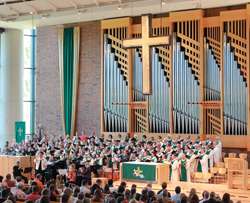
Try miking the amp’s speaker toward the outside of the cone to mellow the HF content of the signal. This technique will have several positive effects.
First, minimizes the bleed of the guitar or bass into the vocal and other mics on stage. Second, it gives the mix engineer more level and audio shaping control over the entire mix, so that an overly loud guitar or bass part will not overwhelm the vocals or other instrumentation.
With praise bands, Diamond insists that the players and singers “do in the sound check what they’re going to do in the service.” Being “inspired” to change instruments, amp settings, positioning, and distances from the mics just before the service can create problems for the person at the console.
Wired Or Wireless?
In churches, as in other settings, more applications that traditionally were filled by wired mics are going wireless – even though wireless units are more costly per channel.
Wireless (versus wired) sells “easily three to one” to his church customers, says Mike O’Rourke of Peach State Audio in Suwanee, GA. About the only wired mics he supplies to these folks are for a podium or in fixed choir positions. Drums often still have wired mics, with most other instruments using DI boxes or going wireless.
The majority of vocalists in larger, more “production-oriented” churches are wireless, providing more range of motion as well as offering the mix engineer more flexibility for channel assignments and positions. AE Global’s Haulk adds that wireless “cleans up the stage” and is easier for the lay person to use since the receivers are “permanently wired into the system,” while the transmitters are able to be flexibly assigned for different applications and locations.
To add versatility to their wireless purchases, churches will often have both a handheld and a beltpack transmitter that can be used with a particular receiver, depending on the requirements of the event. Manufacturers accommodate this flexibility by selling transmitters separately, and in some cases providing pre-packaged sets which include a receiver and both types of transmitters.
When beginning the process of adding wireless, think through the possibilities to the end rather than just filling the immediate need for a minister’s wireless or a mic for a vocalist. By analyzing the possibilities, the current two channels might eventually lead to 12.
An investment in higher quality systems to begin with will make compatibility and interference avoidance easier in the future as well. Also keep an eye on current and upcoming FCC plans for the UHF spectrum with regard to “white spaces” use. All of the leading manufacturers can be helpful in this regard.
Gary Parks has worked in pro audio for more than 25 years, including serving as marketing manager and wireless product manager for Clear-Com, handling RF planning software sales with EDX Wireless, and managing loudspeaker and wireless product management at Electro-Voice.

